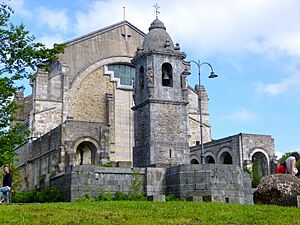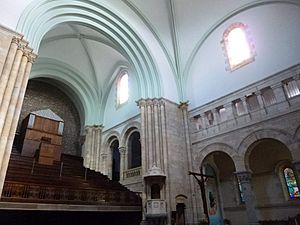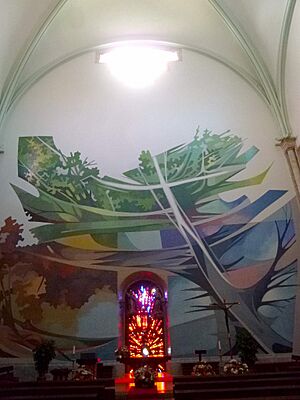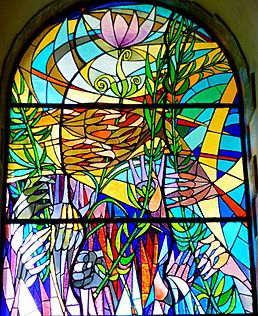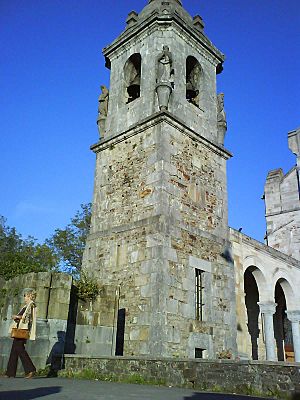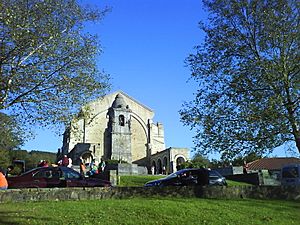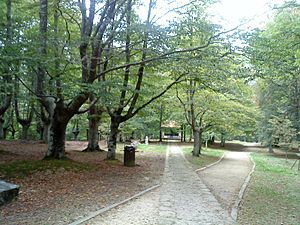Sanctuary of Urkiola facts for kids
The Sanctuary of Saint Anthony the Abbot and Saint Anthony of Padua of Urkiola is a special Catholic church located in the beautiful Urkiola area, in the Basque Country, Spain. It's very old, possibly built between the 8th and 11th centuries, making it one of the oldest in the region. The sanctuary sits right in the middle of the Urkiola Natural Park. It's surrounded by amazing nature, with tall limestone mountains like Anboto in the background. According to old Basque stories, the goddess Mari, also known as the "Lady of Anboto", lives on Anboto mountain.
The church building you see today is the third one built here. It was started in 1899 and opened in 1933, but it was never fully finished. This main building, along with a small bell tower from 1870, the rectory (priest's house), an old hospital, and a guesthouse, form the religious complex. There are also two smaller old chapels, called Santo Cristo and Santa Polonia, a path with Stations of the Cross built in 1943, and a small cemetery nearby.
Contents
About the Sanctuary Building
The sanctuary is built right on a special line where water divides. Rain that falls on one side of its roof flows towards the Mediterranean Sea, while rain on the other side goes to the Cantabrian Sea.
Visitors often notice how big the unfinished church building is compared to the small bell tower from the older church. A large staircase leads up to the main entrance. The entrance is surrounded by the unfinished walls that were meant to be tall towers and a front porch.
The middle part of the church, which was supposed to be the main hall, is now a garden. The small bell tower, built in a Neoclassical style, stands in this garden. Among the plants, there's a small monument that celebrates the ways of life in Biscay. It has an anchor for seafaring, a laia (a farming tool) for agriculture, and a stone turbine for industry.
If you go up to the left, near the entrance, you'll see a unique stone. Many people believe it's a meteorite. Single people are invited to walk around it seven times clockwise. It's believed that doing this will help them find a partner! But if you walk backward, it's said to have the opposite effect.
The side parts of the church are now hallways that lead into the main worship area. The central part of the church has been closed off with a large wall to create the space used for church services.
The church was designed in a neo-medieval style. Because it was never finished, the altar's position was changed. It was moved to lean against the big wall that closes off the main hall. The rectangular area at the front, which was meant for the altar, is now the choir area. On its sides are the sacristy (where priests prepare) and a small chapel dedicated to the Blessed Sacrament.
In the late 1900s, some updates were made to finish parts of the church. These changes, both inside and outside, were supported by a group of former missionaries who started taking care of the sanctuary in May 1970.
Outside, the large entrance staircase was built, and the top of the wall closing the main hall was smoothed.
Inside, the walls behind the altar were decorated with beautiful mosaics. The main altar has a large mosaic covering the wall, with a stained glass window showing the two Saints Anthony, the Abbot and of Padua. Another mosaic covers the chapel of the Blessed Sacrament. A Stations of the Cross path was also created on the floor of the main hall, with an extra Station of the Resurrection. These mosaics and the Stations of the Cross were all made in a workshop right at the sanctuary.
Special Art and Statues
The sanctuary has had several fires over the years, but it still has some amazing statues and artworks.
- The statues of the main saints, Saint Anthony the Abbot and Saint Anthony of Padua, are in a rococo style and date back to the 1600s. They are about 1.10 meters tall.
- A carving of the Virgin Mary and child was given by the Diocesan Museum of Bilbao. It's a Renaissance carving showing Mary sitting with the child on her lap.
- A statue of Christ crucified, from the 1500s, was once part of a church in Durango.
- A carving of Saint Anthony the abbot from the older church used to be in a side altar. In 1690, it was moved to a place called the "Cloister of the Pilgrims," where people left gifts to thank the saints for help.
- A bronze statue of St. Peter is a smaller copy of the famous statue in Vatican City.
Colorful Mosaics and Stained Glass
In the 1990s, the walls behind the altars were covered with mosaics.
- The Mosaic of the High Altar (opened in 1996) covers a huge wall behind the main altar. It was designed by priest José María Muñoz and created by missionary Peli Romarategui. It's 170 square meters and has over 850,000 tiny pieces, taking more than two years to make. It shows a cross turning into a tree that changes through the four seasons, representing human life and the new life of the Resurrected Jesus.
- The Mosaic of the chapel of the Santísimo is smaller and made by the same artists. It frames the statue of the crucified Christ. It has a Greek Cross shape that looks like a cloud or smoke, symbolizing injustice and wars. On the sides are statues of the two Saints Anthony. Below it, in Basque, it says: gora Jainkoa zeruetan, gora itsaso mendietan ('glory to God in the skies, glory to God in the seas and in the mountains').
- Other mosaics include one framing the image of the Virgin and child and another simple one near the sacristy door, listing the names of Basque saints.
- The Stations of the Cross on the floor of the main hall are also mosaics made with large pieces. They are special because they include an extra station for the resurrection.
Along with the mosaics, several stained glass windows were added. The main one is above the High Altar and shows the two Saints Anthony.
- The Stained glass of the High Altar is very colorful. It symbolizes the explosion of a grenade, reminding people of the horrors of war, especially the Spanish Civil War which caused many deaths in this area. Another stained glass window at the top of the wall shows a dove of peace.
- Other stained glass windows were designed by José María Muñoz and made by Peli Romarategui. These include windows on the access doors, showing the sanctuary's shape or hands holding a plant.
- Windows near the sacristy, chapel, and above the choir show the natural plants and trees from the surrounding area.
- On the side walls, there are four stained glass windows showing symbols of the four classical elements: water, air, fire, and earth.
History of the Sanctuary
The Urkiola area has been important for people's beliefs since prehistoric times. Many old remains have been found nearby. The highest mountain, Anboto, is where Basque stories say their main goddess, Mari, lives.
When Christianity arrived, it didn't completely replace the old beliefs. Urkiola remained a very spiritual place. Even without many old documents, it's thought that people worshipped here even before the Middle Ages.
The Sanctuary of Saints Anthony the Abbot and of Padua was built on the site of a much older, simpler chapel dedicated to St. Anton. Records from around 1212 mention gifts given to this chapel. By the 13th century, the sanctuary was dedicated to both Saints Anthony.
In 1625, a new church began to be built to replace the old chapel. This church, shaped like a Latin cross with one main hall and a dome, opened in June 1646. It was used for 15 years. Later, a cloister (a covered walkway) was added, called the pilgrims' cloister, and the choir and sacristy were made larger.
In 1756, the sanctuary became its own parish church, separate from the main church in Abadiño.
Next to the church, a hospital was built for the many travelers who used this important route. It even had a jail and an icehouse. In 1772, the rectory was built.
During a social crisis in the 1800s, the church was closed for a few years, and the statues of the saints were moved. After the crisis, the church reopened, and several updates were made. The most important was building the bell tower in 1870, which you can still see today.
A few years later, church leaders decided to build a much larger church to match the spiritual importance of Urkiola. Architect José María de Basterra designed a huge neo-medieval style church, similar to the new cathedral in Vitoria. It was planned to be 60 meters long and 30 meters wide, with three main halls and two large towers.
On June 13, 1899, the first stone of the new building was laid. The old church was kept in use while the new one was being built. That same year, the hospital burned down.
The first part of the new church opened in 1915, and the second part in 1928. However, the building work stopped because it was too expensive. The old church was then taken down, but its 1870 bell tower was kept. The new church was never fully completed, leaving only the front part and some sections of the halls.
On August 27, 1933, Bishop Mateo Múgica officially opened the church. The main hall was closed off with a wall, and doors were added to the sides, allowing it to be used for worship.
On May 1, 1970, the Basque Diocesan Missions took over the care of the sanctuary. They decided not to finish the building because of the high cost and because the existing space was enough for services.
However, they did make updates to finish the unfinished parts. The outside of the wall closing the main hall was decorated, and the inside was adorned with mosaics (the chapel mosaic opened in 1993, and the High Altar mosaic in 1997) and stained glass windows. In 1991, the large access staircase was built. In 2006, a new guesthouse and an eco-museum were opened.
Legends and Traditions
A popular story says that Saint Anthony of Padua visited Urkiola on his way to Compostela or perhaps back to his hometown, Lisbon. He might have stayed at the pilgrims' hospital and prayed in the old chapel dedicated to Saint Anton. He admired Saint Anton so much that he took his name when he joined the Franciscan order.
Special Rites and Customs
People often give gifts to the sanctuary, including animals like steers, which are then sold at auction.
In the "blessing of the children," mothers bring their babies under one year old to the sanctuary after spending the night there. The child is weighed on a special scale called peso leal (loyal weight), and an offering equal to the child's weight is given. This offering is usually wheat, oil, or wax.
The rock at the entrance of the church is believed to have special powers. As mentioned before, if single people walk around it seven times clockwise, it's said they will find a partner. Walking backward is believed to have the opposite effect. People also leave small gifts, notes, or colored pins for the same reason.
This unique rock, made of many different stones and fossils, was placed in the small square on November 29, 1929. The rector of the sanctuary at the time, Benito de Vizcarra, found the strange stone in a nearby mountain and moved it to an easily accessible spot.
The tradition of walking around this stone to find a partner is linked to an older custom of sticking pins into a canvas in the sacristy. People would use white-headed pins for a blond partner and black-headed pins for a brunette. This tradition of going to Urkiola to ask for a partner led to a popular song:
|
Neska-zarrak joaten dira |
Spinsters go to Urkiola |
| —Urkiola Copla |
Festivals and Important Dates
Two main festivals are celebrated at Urkiola, one for St. Anthony the Abbot and one for St. Anthony of Padua.
- Saint Anthony the Abbot: On January 17, the feast of Saint Anthony the Abbot (also called Saint Anton) is celebrated. This day is dedicated to farm animals. Special rites are performed to keep them healthy, as this saint is known as the protector of animals. This celebration is repeated the following Sunday. Animals are sometimes led over a fire, and blessed bread, soaked in water from the sanctuary, is given to them.
- Saint Anthony of Padua: This feast is celebrated on June 13 and the following Sunday. This saint is asked for help in finding lost items and partners. A pilgrimage (a special journey) is held, and there's a fair for livestock and farm products. He is known as the protector of the poor and those in need.
- St. Joseph: The patron saint of the Diocesan Missions, who manage the sanctuary, is celebrated on March 19.
- Blessing of the children: This special event takes place on the second Sunday of July.
- Married or Family Day: Celebrated on the third Sunday of July, this day includes the tradition of asking for a hand in marriage by walking around the stone at the sanctuary entrance.
- Thanksgiving Day or Urrixena: This day, on the second Sunday of October, is for giving thanks for the harvest from the fields.
- On January 13, 1924, the Urkiola sanctuary was linked to the Roman Basilica of St. John Lateran, which is the Pope's cathedral. This means visitors to Urkiola have the same special benefits as those who visit the Roman temple.
- On June 13, 1854, the famous musician and composer José María Iparraguirre performed his well-known song Gernikako Arbola for the first time in the Basque Country right at the entrance of the Urkiola church.
Other Parts of the Sanctuary Area
Besides the main sanctuary, there are two small chapels (hermitages) and a Stations of the Cross path that are part of the Urkiola complex. These chapels are equally distant from the sanctuary and connected by a road that follows the old Camino Real (Royal Road).
- Our Lady of the Remedies and Saint Apollonia: Popularly called Santutxu, this chapel is on the Camino Real. It's built over a spring that flows into a large fountain with a washing area. The water from this fountain is believed to have healing powers. Since Apollonia is the patron saint of dentists, many believe the water is good for teeth and toothaches. For the water to work, people say you should take water in your mouth, walk around the chapel three or seven times, then spit the water inside while praying to the saint.
- Santo Cristo or de La Vera Cruz: Like the previous one, this is a chapel on the edge of the old Camino Real. Tradition says that pilgrims used to take off their shoes here before reaching the sanctuary. It was built in 1663.
- Stations of the Cross and Calvary: Built in 1943, this is a special double Stations of the Cross path. The way out is different from the way back, leading to a Calvary (a place representing where Jesus was crucified) located on a natural balcony overlooking the Atxarte gorge and Durangaldea.
See also
 In Spanish: Santuario de Urkiola para niños
In Spanish: Santuario de Urkiola para niños


